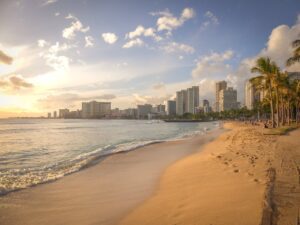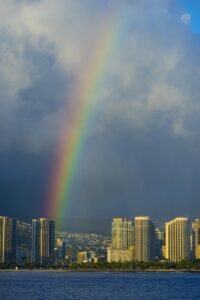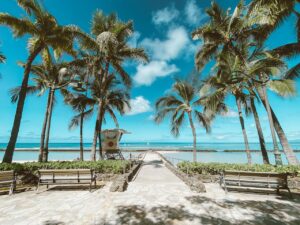Hawaii
Hawaii, the 50th state in the U.S., is a group of islands situated in the Pacific Ocean, roughly 2,000 miles from the U.S. coast. Renowned for its breathtaking natural scenery, deep cultural roots, and lively past, Hawaii is a destination that enthralls the minds of visitors worldwide.
This piece explores the different aspects of Hawaii, examining its landscape, historical background, cultural traditions, and the reasons it is highly coveted by tourists worldwide.
History of Hawaii
 Hawaii’s history is intricate and diverse, spanning from the arrival of its early Polynesian settlers to its current status as a state in the United States.
Hawaii’s history is intricate and diverse, spanning from the arrival of its early Polynesian settlers to its current status as a state in the United States.
Polynesian Settlement: Approximately 1,500 years ago, Polynesians were the first to settle in Hawaii, navigating the expansive Pacific Ocean in canoes. These settlers established a flourishing society with a sophisticated social system and a profound connection to the natural environment.
The Hawaiian Kingdom: King Kamehameha I unified the Hawaiian Islands into a single kingdom in 1795 after years of conflict. The Kamehameha dynasty ruled Hawaii until 1872, succeeded by the House of Kalākaua. Queen Liliʻuokalani, the last reigning monarch, was overthrown in 1893 by a group of American businessmen, ultimately leading to Hawaii’s annexation by the United States.
Annexation and Statehood: In 1898, Hawaii was annexed by the United States and became a U.S. territory. On August 21, 1959, Hawaii achieved statehood as the 50th state of the United States. The journey to statehood was marked by significant events such as the attack on Pearl Harbor on December 7, 1941, which prompted the U.S. entry into World War II.
How to Reach:
- By Air: The primary way to reach Hawaii is by air. The major international gateway is Daniel K. Inouye International Airport (HNL) in Honolulu, located on the island of Oahu. Direct flights are available from major cities across the United States, including Los Angeles, San Francisco, Seattle, and New York. Additionally, international flights from cities in Asia, Oceania, and Canada also connect to Honolulu. Upon arrival, travelers can take connecting flights to other Hawaiian islands like Maui, Kauai, and the Big Island via Hawaiian Airlines, Southwest Airlines, or Mokulele Airlines. The flight to Hawaii offers breathtaking aerial views of the Pacific Ocean and, as you descend, the lush, volcanic landscapes of the islands.
- By Cruise: For those who enjoy sea travel, several cruise lines offer transpacific cruises from the mainland United States to Hawaii. These cruises typically depart from West Coast ports such as Los Angeles, San Francisco, and Vancouver, taking approximately four to five days at sea before arriving in Hawaii. Once in Hawaii, these cruises often include island-hopping itineraries, allowing passengers to explore multiple islands with ease while enjoying panoramic views of the Pacific and Hawaii’s coastline.
- By Private Yacht: For the adventurous, private yachts can be chartered to sail to Hawaii from the mainland U.S. or other Pacific islands. This journey is long and requires careful planning, but it offers a unique and luxurious way to arrive in Hawaii, allowing you to explore hidden coves and less-visited islands along the way. This option is ideal for those seeking a personalized experience and the freedom to explore Hawaii’s remote coastal areas at their own pace.
- By Inter-Island Flights: If you’re already in Hawaii and wish to explore other islands, inter-island flights are the most efficient option. Hawaiian Airlines and Southwest Airlines operate frequent flights between the islands, with flight times ranging from 20 minutes to an hour. This allows you to hop between islands, each offering unique landscapes and experiences, from the vibrant city life of Oahu to the tranquil beaches of Kauai.
Top Attractions:
 Hawaii is brimming with natural beauty and cultural landmarks, making it a top destination for travelers. Here’s a quick guide to some must-see attractions across the islands.
Hawaii is brimming with natural beauty and cultural landmarks, making it a top destination for travelers. Here’s a quick guide to some must-see attractions across the islands.
- Waikiki Beach (Oahu) : Waikiki Beach in Honolulu is the most renowned beach in Hawaii, ideal for surfing and swimming. Just a short walk away, you can climb Diamond Head Crater for sweeping vistas.
- Pearl Harbor National Memorial (Oahu): Take a trip to Pearl Harbor to delve into the history of the USS Arizona Memorial and other significant sites, gaining a profound understanding of World War II.
- Hanauma Bay Nature Preserve (Oahu): Hanauma Bay is a premier spot for snorkeling, boasting colorful coral reefs. Before diving in, learn about the importance of reef conservation.
- Road to Hana (Maui): Enjoy the picturesque views of waterfalls, rainforests, and coastal cliffs along the Road to Hana, with numerous opportunities for hiking and photography.
- Haleakalā National Park (Maui): Witness the awe-inspiring sunrise from Haleakalā Volcano’s peak, then venture into the park’s distinctive volcanic terrain through various hiking trails.
- Nā Pali Coast (Kauai): The Nā Pali Coast is a must-visit, featuring towering cliffs and verdant valleys. Discover it by hiking, boat, or helicopter for unforgettable vistas.
- Waimea Canyon State Park (Kauai): Known as the “Grand Canyon of the Pacific,” Waimea Canyon presents dramatic landscapes and hiking trails with stunning vistas.
- Hawai’i Volcanoes National Park (Big Island): This park is the cradle of active volcanoes Kīlauea and Mauna Loa, offering the opportunity to observe volcanic activity and explore lava tubes.
- Akaka Falls State Park (Big Island): Akaka Falls, a 442-foot waterfall, stands out as the centerpiece of this park, encircled by dense rainforest and accessible via a brief trail.
- Molokini Crater (Maui): This circular volcanic caldera is a premier destination for snorkeling and diving, teeming with marine life in crystal-clear waters.
- Polynesian Cultural Center (Oahu): Immerse yourself in Polynesian cultures through engaging exhibits, live performances, and an evening show at the Polynesian Cultural Center.
- Lanikai Beach (Oahu): Lanikai Beach is celebrated for its pristine white sand and tranquil turquoise waters, providing a serene retreat with views of the Mokulua Islands.
- Mauna Kea Summit (Big Island): Mauna Kea’s summit is renowned for its spectacular sunset views and top-notch stargazing opportunities, home to some of the world’s leading observatories.
- Iao Valley State Park (Maui): Discover the lush Iao Valley, home to the famous Iao Needle and a wealth of cultural history, with its easy trails and scenic vistas.
- Kalaupapa National Historical Park (Molokai): This secluded park narrates the story of the Kalaupapa leprosy settlement and the remarkable efforts of Saint Damien and Saint Marianne Cope.
Where to Stay
Hawaii presents a broad selection of places to stay, ranging from upscale resorts to economical hotels and vacation homes. Below is a brief overview of the top spots for lodging on each island.
- Oahu: Waikiki stands out as the most popular destination, featuring a variety of hotels and resorts close to the beach, shopping, and dining areas. For a more peaceful stay, consider the North Shore, famous for its surfing spots and relaxed environment. Kailua, located on the windward side, boasts gorgeous beaches and a more local feel.
- Maui: Kaanapali Beach is a top pick for high-end resorts, with picturesque beaches and top-notch facilities. Wailea is another excellent option for upscale lodgings and premier golf courses, while Paia and Hana offer more secluded, upscale choices for those looking for a quiet retreat.
- Kauai: Princeville on the north shore is renowned for its high-end resorts and breathtaking views of the Nā Pali Coast. Poipu on the south shore is an ideal spot for family-friendly resorts and warm weather. Kapa’a provides more budget-friendly alternatives and is a convenient hub for exploring the island.
- Big Island: The Kohala Coast is the area with the most luxurious resorts, with access to stunning beaches and golf courses. Kailua-Kona offers a variety of resorts and budget-friendly hotels, along with easy access to local restaurants and activities. Hilo serves as a solid base for discovering the island’s lush eastern region and its proximity to the Hawai’i Volcanoes National Park.
- Molokai and Lanai: Molokai has a more limited selection of accommodations, focusing on smaller, boutique hotels and vacation rentals that provide a more genuine Hawaiian experience. Lanai features two high-end resorts: Four Seasons Resort Lanai and Sensei Lanai, both offering top-tier facilities in a secluded setting.
Best Time to Visit Hawaii
 Hawaii experiences a tropical climate with two primary seasons:
Hawaii experiences a tropical climate with two primary seasons:
- The summer season (Kau) lasts from May to October, featuring higher temperatures and reduced precipitation
- The winter season (Hooilo) stretches from November to April, bringing lower temperatures and increased rainfall, especially on the windward sides of the islands.
The most suitable time for a visit to Hawaii greatly depends on the experiences you seek. For those who enjoy the beach and sunshine, summer is the preferred choice.
Winter is an excellent time for observing whales, as humpback whales migrate to Hawaii’s warm waters. Surfing enthusiasts should also consider a winter visit, as the waves on the North Shore of Oahu are at their best.
Safety Tips:
Hawaii is a safe destination, but here are some key tips to ensure a smooth trip:
- Beach Safety: Choose beaches with lifeguards on duty and be mindful of powerful waves. Stay out of the water when there’s a red flag warning and be careful of the ocean during the colder months.
- Sun Safety: Apply sunscreen with an SPF of 30 or higher, wear a cap, and drink plenty of water. The sun’s rays are intense, so take steps to prevent sunburn and overheating.
- Trail Safety: Stay on designated paths, carry water, and keep an eye on the weather. Let someone know where you’re going and begin your hikes early to avoid the heat.
- Volcanic Risks: In volcanic regions, adhere to the rules of the park and stay updated on any volcanic activity. Avoid entering restricted zones due to possible hazards such as harmful gases.
- Preventing Theft: Keep your valuables with you on the beach or in the car. Utilize hotel safes and secure your items to prevent minor theft.
- Road Safety: Exercise caution, particularly on narrow or curvy roads. Obey the speed limit and remain patient with fellow motorists, especially on picturesque drives.
- Cultural Sensitivity: Honor places of worship, dress in a manner respectful of local customs off the beach, and seek permission before taking photos of individuals or their property.
- Preparing for Disasters: Be vigilant about the local emergency plans for natural disasters like hurricanes, tsunamis, and earthquakes. Register for alerts and heed the guidance of authorities during crises.
Credits:
- Photo by Tyler Lastovich: https://www.pexels.com/photo/building-beside-shore-412681/
- Image by I M from Pixabay
- Photo by Jess Loiterton: https://www.pexels.com/photo/palm-tree-near-body-of-water-4327716/
Conclusion:
Hawaii presents a unique combination of stunning natural scenery, thrilling activities, and rich cultural encounters.
Whether you’re unwinding on Maui’s sandy shores, discovering the volcanic wonders of the Big Island, or diving into the rich heritage and traditions of Oahu, Hawaii guarantees an unforgettable adventure.
Welcome the spirit of Aloha, and allow Hawaii’s mesmerizing vistas and friendly welcoming nature to deeply touch your spirit.